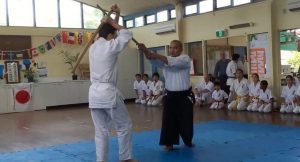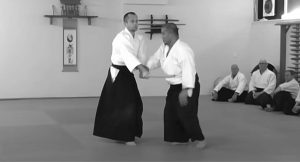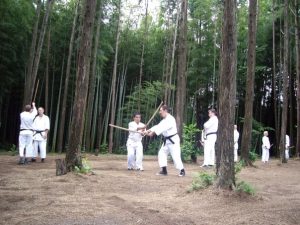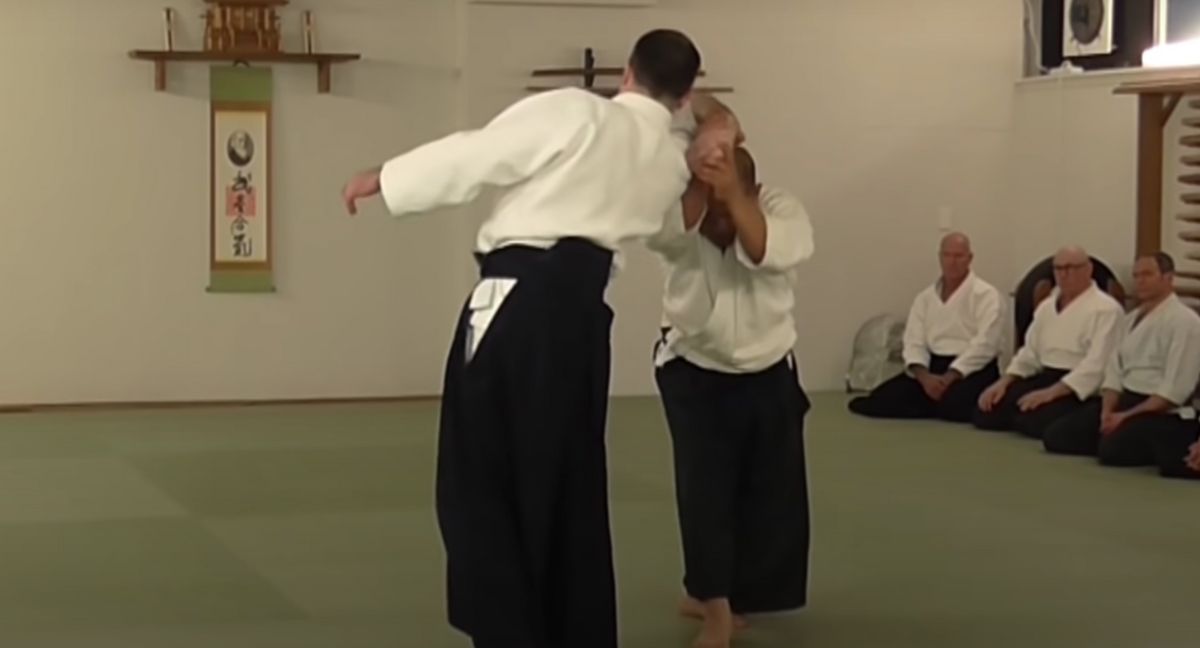Have a Good Aikido Bokken from The Start
A Bokken is a wooden sword that the Aikidoka and other Japanese Martial Artists use to learn the art of the sword. The Aikidoka uses the bokken (wooden sword) for training because it’s safer than practising on a live razor-sharp katana. If you use a real sharp samurai sword (katana) for training, chances are you will cut or injure yourself before you get better.
Aikido Boken, Bokken, or Bokuto
Firstly let’s establish what is the proper term for the wooden sword.
A bokken (木剣, bok(u), “wood”, and ken, “sword”) (or a bokutō 木刀, as they are called in Japan) is a Japanese wooden sword used for training. It is usually the size and shape of a katana but is sometimes shaped like other swords, such as the wakizashi (short sword) and tantō (knife or dagger). Sometimes it is spelt “boken” in English. Bokken should not be confused with shinai, practice swords made of flexible bamboo. The boken, bokken, or bokuto is not exclusive to Aikido, however, it is necessary for the practice of Aikido.
In Japan, a bokken is called ‘Bokuto’. In fact, when I was in Tokyo most people I spoke to called it Bokuto. I’ve noticed that the Japanese term ‘Bokken’ is more used in the dojo during Keiko. During day-to-day conversation, it’s better to use the word Bokuto (bokuto).
In Australia, we call it ‘bokken’. I rarely almost never hear it called bokuto at all. Then most of the Japanese I speak is ‘dojo Japanese’. I started calling it bokuto whenever I have Japanese students or visitors in the dojo.
Back to Sydney, for years I’ve even spelt bokken as ‘boken’. I started spelling it ‘bokken’ quite recently because I’ve noticed that it seems to be the universal anglicised spelling for it.
When I went to Japan to train as an uchi-deshi (live-in student), I quickly found out that the Japanese call it ‘Bokuto’ when three security officers at Narita Airport questioned me on why I was carrying them.
For the sake of simplicity and the purpose of this article, I will call the Japanese two-handed wooden sword as ‘bokken’. I will also use the word ‘ken’ interchangeably with the word ‘sword’ in this article. Also, the Japanese word doesn’t become plural by adding the letter ‘s’ as a suffix. Hence I am writing the word ‘bokken’ (rather than bokkens) even though I am describing it in its plural form.
Why use a wooden sword when practising Aikido?
The bokken’s simple wooden construction demands less care and maintenance than a katana. In addition, training Aikido with a bokken does not carry the same ‘mortal’ risk associated with that of a sharp metal sword, both for the user and other practitioners nearby. While its use has several advantages over the use of a live edged weapon, it can still be deadly, and any Aikido training with a bokken should be done with due care. Injuries occurring from bokken are very similar to those caused by clubs and similar battering weapons and include compound fractures, ruptured organs, and other such blunt force injuries.
In some ways, a bokken can be more dangerous as the injuries caused are often unseen and inexperienced practitioners may underestimate the risk of harm. I guess what I am trying to say is because a bokken is a blunt stick, we don’t see the danger it can cause, and we underestimate it.
I cannot highlight this any harder, please DO NOT use the bokken as a sparring weapon. It is intended to be used in kata and to acclimate the student to the feel of a real sword. For sparring, a bamboo shinai is typically used instead for obvious safety reasons and wear armour if you are going to do this.
Which one should I get if I am just starting Aikido?
Good question. I believe you should get a good one straight away because you don’t want to blame your tool (Ken) when you are just learning. No, I am not saying go for the most expensive one, I said go for a good Aikido bokken. I bought three cheap ones (just because I was cheap), they broke or I gave them away because it wasn’t balanced. I should have just gone for the good Aikido bokken to start with. Also learning the Aiki Ken starts with the Ken Suburi. When starting suburi your form will be affected by your ken’s shape, weight, and balance. Might as well start with a good Aikido bokken so all you have to worry about is your own form and technique.
As you progress in Aiki, you’ll start collecting them on your journey, so just get this set and start training. Don’t get stuck with choosing your weapons. It is more important to learn how to use them safely and skillfully.
Get a Weapons Bag
I cannot highlight or be blatantly absolutely obvious about this point.
Get a good Weapons Bag or Case. You cannot walk around with a stick or a bokken without frightening your fellow human being or getting noticed by the police. You are an Aikidoka. Hide your power. Cover your weapons. Blend in with everyone and don’t bring unwanted attention to yourself. This is part of your Aikido journey. Learn to harmonise with everyone. Do not frighten your fellow human beings.
My Aikido Bokken collection

“My bokken collection or should I say my surviving bokken collection”.
Here is my bokken collection or should I say my surviving bokken collection. Each serves a different purpose.
A) Kamagong Ironwood Ken (950 gms) – This bad boy is solid. I use it for suburi practice. After using this for suburi for years, all the other bokken feels lighter and easy to wield. I don’t really use it for Kumi Tachi or any partner practice because it has a sharp edge.
If your partner failed to parry your Tsuki (thrust) and it accidentally hit them, the edged tip will definitely hurt a lot. Also, during Kumi Tachi, I can feel every hit transfer from the ken and unto my hands, joints, and arms. It feels like you are using a jackhammer. I got this bokken when I was in Manila of which the Kamagong ironwood is a native.
B) White Oak (800 gms) Iwama Ryu style made in Japan – I got this one from a friend that bought it from me. It was quite pricey and I paid a bit too much back then.
This bokken is beautifully balanced. It has a minimal curve a low arc. When doing go-no-awase with it, you really need to get your position right when thrusting (Tsuki) and really hide your shoulder during ‘hitoemi’ when parrying. It will really drill those techniques in. It is on the heavy side, however, this bokken has broken other cheap bokkens ($15 to $30) used by my partners during normal practice.
C) White Oak Ken (750 gms) Iwama Ryu style – Our dojo bought ten of these this one from E-Bogu about four years ago. It’s not bad, personally, I think it is a good beginner bokken. It is tough enough to withstand the battering that a keen (overzealous) kyu grade will give. I accidentally left it in the boot of my car, under the harsh Australian sun, and it didn’t warp (please don’t do this).
D) Japanese White Oak (650 gms) Iwama Ryu – I got this ken during my visit in Iwama Japan. I have used this ken during rain, hail, or shine and it didn’t warp. It is lighter than all my other bokken. Initially, I was concerned that it may break on impact, however, it has this ability and flexibility to absorb impact. I guess this stock of Japanese white oak is really doing a good job. With this bokken, I feel that I can wield the sword better and I can do my Aiki-ken techniques with ease. This is definitely my favourite.
The type of wood for your bokken
Red Oak – I find the red oak on the heavy side. I gave away all my red Oak bokken. Having said this, red oak is my favourite jo (staff) timber
White Oak – White oak is strong yet light. It is also flexible can absorb impact without transferring it to your hands, joints, arm, and spine. The bokken using this type of timber is good for partner practice such as Kumi-Tachi and Ken-Tai-Jo.
Hardwood – Hardwood is heavy and very good for suburi or tanren exercises. You can still use it for Kumi-Tachi, however, be prepared for the impact on your body and the possibility of breaking your partner’s ken.
Pinewood – This is a waste of money and timber. They should stop making bokuto out of pine.
If you have the chance to physically inspect the bokken first before you buy, this is what you need to look out for
- Be mindful of the grain.
- Ideally, you want the grain to run from the hilt to tip of the ken.
- You want the grain to be parallel to the sword and the distance of between the grain is even and small.
- If the grain is twisted, the wood is prone to warp. You don’t want a warped sword.
- Watch out for knots in the wood. If there are knots, you don’t want one in the middle of the blade or the ‘sharp’ end of the ken. This will break on impact. I personally won’t buy a bokken if I see knots on it.
- Literally check the bokken length. The bokken length should be 103 cm (27 cm) on the dot. You don’t want bokken length to be even a cm shorter or longer. The length of the bokken will affect the balance of your bokken, your swing (suburi), and your Kumi Tachi (partner practice). The bokken is going to be your sword, you want it to be good. You want it to have the correct bokken length.
- The hilt should be long enough to fit three of your fist. If it is not, that ken is either too long or short for you.
- If you are doing Aikido, don’t buy a bokken with a hilt or tsuba. This type of bokken is for other martial arts. For Aikido, only buy the Iwama Ryu Bokken because it is designed for Aikiken, Ken Tai Jo, and Riai.
What is the ideal weight for my bokken?
I understand that you are probably thinking that 950 grams is not really heavy. Well if you train with the sword for three hours to eight hours straight a day and have lifted and cut a thousand times with it, you will surely notice what 950 grams really feels like.
If your sword is too light, then your partner’s heavier sword’s momentum can overwhelm or break it. If your sword is too heavy, it will slow you down. Think about it this way, if your first and last line of defence is your sword, you would hope that you can lift it fast enough to block or parry a shot to your head.
For me, the average weight of a bokken is around 700 to 800 gms. For suburi practice, I use an 800-gram bokken. For tanren practice, I use a bokken that is at least 950 grams or a suburito up to 1500 grams (1.5 kgs).
How much should I spend on my bokken?
Cheap $15 to $35 (avoid buying these ones, if you intend on using your bokken for Aikido Kumi-Tachi)
Beginner up to $50
Expert up to $150
A bokken that is more than $150 is a reap-off. Seriously, DO NOT buy a bokken that is more than $150. I know this because I paid for one, and it wasn’t worth $150. I don’t care how special is the timber or where it came from, but $150 for a stick is expensive.
Bokken and Bukiwaza
There are two main pillars in Aikido, Bukiwaza and Taijutsu.
Buwikaza in Aikido involves the use of the ken (sword), jo (staff), and knife (tanto). The ken is physically used in bukiwaza, however, the shape, form, and movement that is developed through practice are used in taijutsu.
The ken is used in the following Aikido exercises and Waza
Ken Suburi

Suburi (素振り:すぶり?), a word that translates literally to something like “elementary swinging”, is used to refer to the basic solo movements of Aiki-Ken, developed as a building block of the partnered practice.
There are seven Aiki-Ken suburi as passed by Saito Sensei
- Ichi-no suburi: A simple downward vertical cut.
- Ni-no suburi: Step back into jōdan-no-kamae, then a downward vertical cut.
- San-no suburi: Step back into waki-gamae, then a downward vertical cut.
- Yon-no suburi: Step forward with a downward vertical cut (Shomen Uchi). Repeat.
- Go-no suburi: Step forward while guarding, then downward cut (Yokomen Uchi). Repeat.
- Roku-no suburi: Step forward with a downward vertical cut, then shuffle forward and thrust.
- Shichi-no suburi: Step forward while guarding, then a downward cut, then step forward and thrust.
Kumi Tachi
- Ichi-no-Tachi (一の太刀): first sword technique
- Ni-no-Tachi (二の太刀): second sword technique
- San-no-Tachi (三の太刀): third sword technique
- Yon-no-Tachi (四の太刀): fourth sword technique
- Go-no-Tachi (五の太刀): fifth sword technique
Ki No Musubi No Tachi

Tachi Dori

Ken Tai Jo

Subscribe To My Newsletter
BE NOTIFIED ABOUT BOOK SIGNING TOUR DATES
Donec fringilla nunc eu turpis dignissim, at euismod sapien tincidunt.









